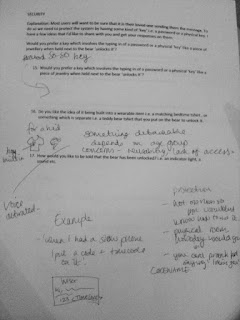Summary of the focus group
New user base: Younger people – going travelling/away at uni because this was the preferred choice. Aged 18-25. Male or female.
Context of use: In the home at any space within it-portability was very important to all users.
Form: form should be tailored to the user base. The teddy bear was the most popular within the focus group, but this may change when a new specific user base is tested.
Functional requirements: Users should be able to push a button and send a message ‘I’m thinking about you’ without having to continually hold onto is. The ‘hug’ motion was preferred, so users should be able to close the bears arms briefly to send the message. The bear should be portable. The sound needs to be loud enough to hear from a different room, and should only play once. The user sending the message should get visual feedback that their message has been received.
Non-functional requirements: The interaction should not be too obvious as a security feature to protect the system instead of a keypad input/physical key. The users could feel the wiring inside the bear, so a slightly bigger bear is required.
Scenario: Jane is going away from home so her sister Sarah buys a ‘Teddy Share’ Bear and records a voice message for her as a going away present. Whenever Sarah is missing Jane she makes her bear send a ‘hug’ by closing its arms and this is transmitted to Jane who hears Sarah’s voice. It is very personal because she can hear Sarah’s voice and it provides a real-time connection to Sarah and lets her know that she is thinking about her right at that moment.
Persona
Jane is a 19 year old student who is moving away from home to start her art degree. She has a teddy bear that her mother bought her when she was a baby and whenever she sees it, it reminds her of her mum. Jane has never been away from home for so long before. She is used to her sister Sarah being around, and will miss her. She is given the Teddy Share bear by Sarah to take with her. Sarahs voice is recorded in the bear and will be sent whenever she is missing her. Sarah does not have to say anything else, it is just a simple message. Jane and Sarah communicate through the bear and the messages cannot be re-captured. It creates a new experience for them both to engage with.
Affordances: The bear will have markings sewn/painted onto it to illustrate where the user has to press. This was because the users has to be shown exactly where to push the trigger when it was embedded so this problem with re-occur with the new design.
Constraints: A message can only be sent every so often.
User type is Novice & Infrequent. Affordances will mean that once instructed the user should know how to use the bear, but there will be an instruction manual. As an SD card is incorporated, the users could record their own messages in person. All users are also primary users (they have hands on interaction with the device).
ESSENTIAL USE CASE DIAGRAM
USER INTENTION | SYSTEM RESPONSIBILITY |
send a message | |
transmit the message | |
provide feedback that the message has been successfully sent |
HOW TO HELP USERS FORM THE CORRECT MENTAL MODELS:
· AFFORDANCE, SIMPLICITY, FAMILIARITY (similarity to existing systems), AVAILABLITY (Recognition and cues to reduce memory load, FLEXIBILTY (access to all objects anytime), FEEDBACK (Complete and continuous aids action validity)
· These have all been considered in the design.
Screen-shots of the notes from the session







No comments:
Post a Comment